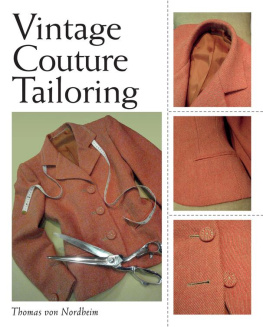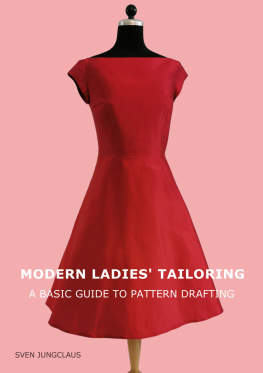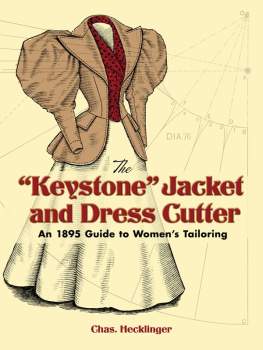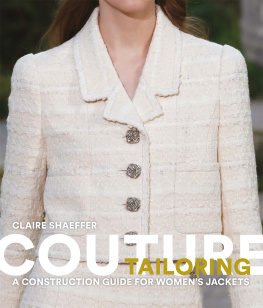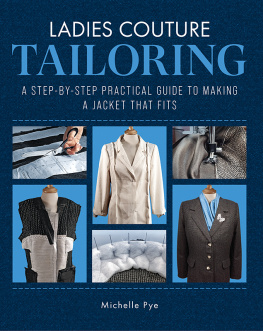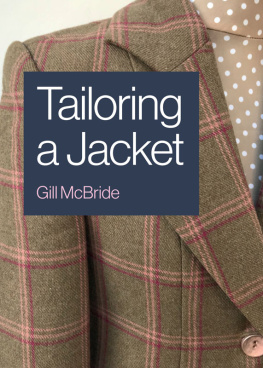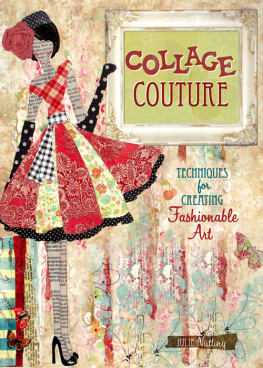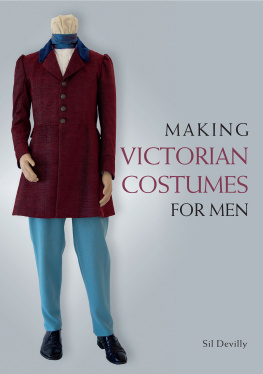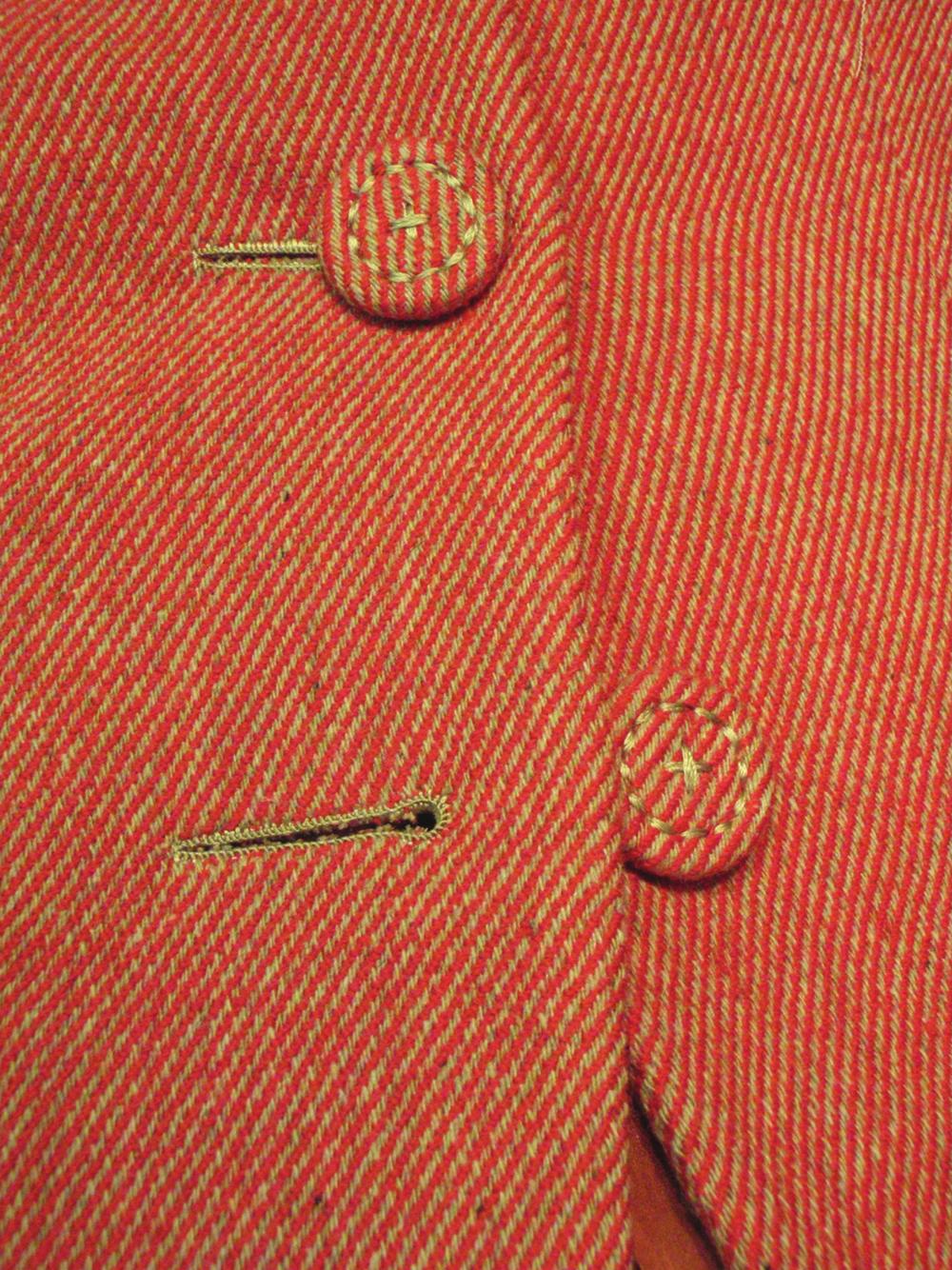First published in 2012 by
The Crowood Press Ltd
Ramsbury, Marlborough
Wiltshire SN8 2HR
www.crowood.com
This impression 2012
This e-book first published in 2013
Thomas von Nordheim 2012
All rights reserved. No part of this publication may be reproduced or transmitted in any form or by any means, electronic or mechanical, including photocopy, recording, or any information storage and retrieval system, without permission in writing from the publishers.
British Library Cataloguing-in-Publication Data A catalogue record for this book is available from the British Library.
ISBN 978 1 84797 588 1
We live in an age in which fashion and clothing have become casual, fast-lived consumables. For many people the number of items in their wardrobe and how often they change them is more important than their quality and longevity. Because of that, clothes no longer need to be made to last.
This has not always been so. Even fifty or sixty years ago clothes used to be purchased only every so often and even when bought off the peg, they were constructed to last and were handed down, remodelled, mended, and cherished. The craft of tailoring was well regarded and most towns had their tailors and dressmakers, frequented even by people of limited means. National UK statistics of the 1930s indicate that every other man in the population had a suit made every two years. It is likely that women called upon their tailors even more often, to have their costumes made (as suits were called back then). In addition most women knew how to sew; if they had not learned sewing at school they would have been taught by their mothers and often showed considerable skill in manufacturing dresses and basic tailoring for themselves, as well as clothing their children.
With the disappearance of handicrafts (most of them in fact), whether due to technical advances in manufacturing, rising costs of labour and cheap competition from the East, or changes in attitude most likely a combination of all of these a good deal of culture and its associated base of skilled artisans have vanished from our lives. Apprenticeships have mostly disappeared, aside from the fact that most young people nowadays aim to pursue a career after going to university, rather than learning a trade; even some MA fashion design students lack very basic construction skills. Yet it requires modellers, pattern cutters, fitters, tailors, dressmakers, machinists and hand finishers to put designers visions into reality. The question is how long it will be before there are only a few people left who will be able to pass on their knowledge. Already there is a shortage of experienced technicians at colleges and the remaining bespoke tailors complain of having difficulty in hiring highly skilled staff.
In recent years the trend has returned towards handcrafted products, mostly textiles-based accessories, but also niche market clothing with a twist on something for example reconstructed vintage or garments made from ecologically sourced fabrics with a particular provenance. A new generation of environmentally conscious middle-class consumers is looking for customized, well-made but quirky clothes with individuality. They are tired with what they can find in the high street or in expensive designer boutiques. This must be a welcome trend, but has little to do with craftsmanship or indeed couture.
In these modern times, a few couture houses are surviving like dinosaurs and cater for this already rare species, the typical couture client: mature, discerning, used to the best of everything, knowledgeable about quality and fit, able and prepared to pay. In their view the expense of having clothes made is well worth it: many upper-class people wear their bespoke clothes until they literally fall apart, having got more than their moneys worth out of them. The garments have lasted well in the first place because of their superior materials and construction. Moreover, their classic style remained fresh over many years. Ultimately this means fewer clothes, but of better quality. Even people with lesser means should learn from this attitude; couture clothes are often seen as a luxury, but are actually worth every penny. Truly extravagant are those people who consume cheap, high-fashion items and discard them after wearing a few times. Historically, couture has always done well in times of recession, showing that even in times like this, those who prefer flawless craftsmanship and no-nonsense styles will not accept second best. They would rather buy one or two fewer outfits a year, but still commission investment pieces.
Couture is not about sketching pretty clothes and entertaining glamorous clients. Making bespoke clothes is hard work and this should be considered if you are thinking of using your skills professionally. Fashions aside, you need to be able to customize designs and have an aesthetic feel for colours, fabrics and textures, as well as an understanding of what suits different figures. Next comes the cutting, a profession in itself, and there are also many different technical skills in garment manufacture. Fitting is another most important skill, as every clients figure is different couture clients used to consider their fitters more important than the designers, and would follow them to other houses. Lastly you have to have the necessary skills to run the business side: there will be frantic periods and those with no orders at all. This advice is not intended to discourage, but it is important to learn to walk before you run. Every piece has a soul: the cut and shape, colour and texture are as individual as the style and personality of the customer who is going to wear it!
Many people have taken up sewing as a hobby again, as proven by increased sales of sewing machines in recent years, and this is an encouraging development. As opposed to paying a lot for having their clothes made, those who actually work the couture way are investing a good deal of time and effort in their work. They will come to appreciate the amount of labour and skill that goes into the manufacture of bespoke garments. Needless to say they can choose what really suits and flatters their physique and can creatively customize their wardrobes by building up useful unique pieces. There is of course the added satisfaction of achievement, having made something yourself which you can wear with pride.
Although an advanced skill, traditional handcraft tailoring in its pure form is the base for all other sewing. A tailor can make a dress, but a dressmaker cannot make a tailored jacket. Most stitches in tailoring encompass those used in other needlecrafts, including millinery. This book will explain step by step how to build a jacket from scratch. It is a ladies jacket tailored the mens way, but the techniques can be utilized in the manufacture of garments for either gender. The cut, governed by style and the female anatomy, as well as some minor finishing details (most of which are invisible from the outside) would differentiate the jackets. Learning how to make a tailored jacket includes fundamental skills and techniques that will be useful for all your other sewing projects. Whether you are a professional wishing to refresh or deepen your knowledge or a sewer wanting to explore tailoring, this book is dedicated to all those who appreciate quality and craftsmanship and wish to know more about the trade secrets that hide behind the mystique of old-school couture tailoring.

